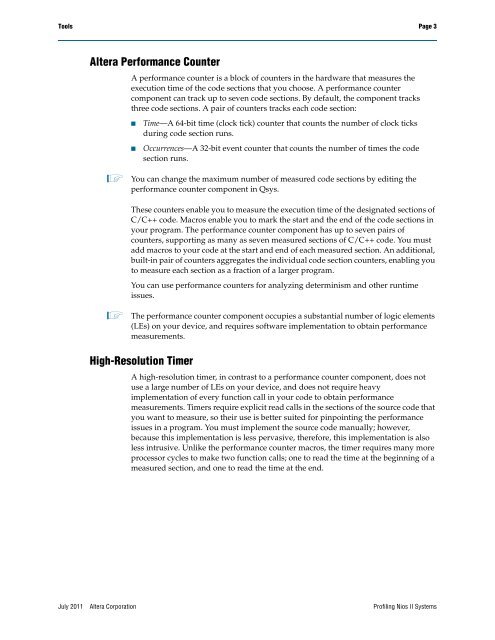Profiling Nios II Systems Application Note 391 - Altera
Profiling Nios II Systems Application Note 391 - Altera
Profiling Nios II Systems Application Note 391 - Altera
Create successful ePaper yourself
Turn your PDF publications into a flip-book with our unique Google optimized e-Paper software.
Tools Page 3<br />
<strong>Altera</strong> Performance Counter<br />
A performance counter is a block of counters in the hardware that measures the<br />
execution time of the code sections that you choose. A performance counter<br />
component can track up to seven code sections. By default, the component tracks<br />
three code sections. A pair of counters tracks each code section:<br />
■ Time—A 64-bit time (clock tick) counter that counts the number of clock ticks<br />
during code section runs.<br />
■ Occurrences—A 32-bit event counter that counts the number of times the code<br />
section runs.<br />
1 You can change the maximum number of measured code sections by editing the<br />
performance counter component in Qsys.<br />
These counters enable you to measure the execution time of the designated sections of<br />
C/C++ code. Macros enable you to mark the start and the end of the code sections in<br />
your program. The performance counter component has up to seven pairs of<br />
counters, supporting as many as seven measured sections of C/C++ code. You must<br />
add macros to your code at the start and end of each measured section. An additional,<br />
built-in pair of counters aggregates the individual code section counters, enabling you<br />
to measure each section as a fraction of a larger program.<br />
You can use performance counters for analyzing determinism and other runtime<br />
issues.<br />
1 The performance counter component occupies a substantial number of logic elements<br />
(LEs) on your device, and requires software implementation to obtain performance<br />
measurements.<br />
High-Resolution Timer<br />
A high-resolution timer, in contrast to a performance counter component, does not<br />
use a large number of LEs on your device, and does not require heavy<br />
implementation of every function call in your code to obtain performance<br />
measurements. Timers require explicit read calls in the sections of the source code that<br />
you want to measure, so their use is better suited for pinpointing the performance<br />
issues in a program. You must implement the source code manually; however,<br />
because this implementation is less pervasive, therefore, this implementation is also<br />
less intrusive. Unlike the performance counter macros, the timer requires many more<br />
processor cycles to make two function calls; one to read the time at the beginning of a<br />
measured section, and one to read the time at the end.<br />
July 2011 <strong>Altera</strong> Corporation <strong>Profiling</strong> <strong>Nios</strong> <strong>II</strong> <strong>Systems</strong>
















